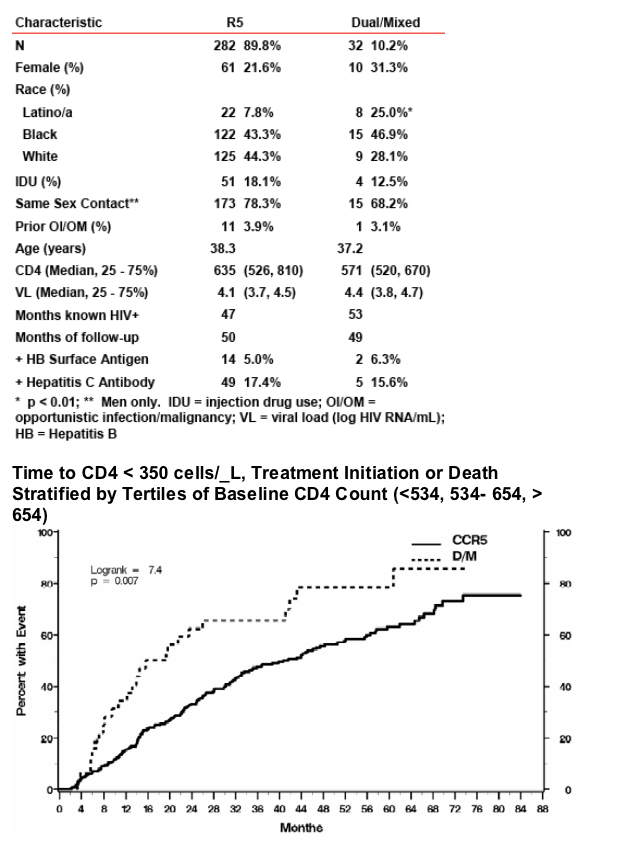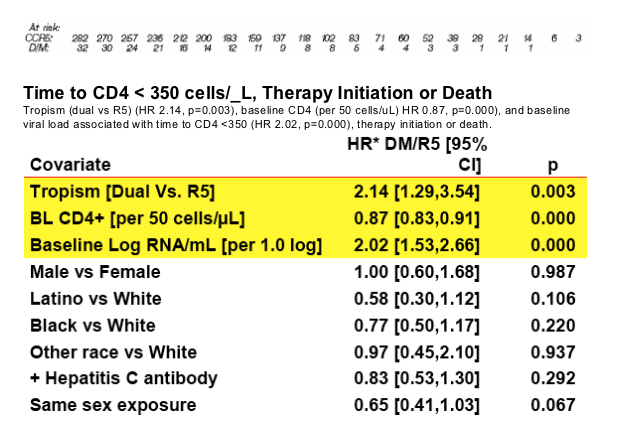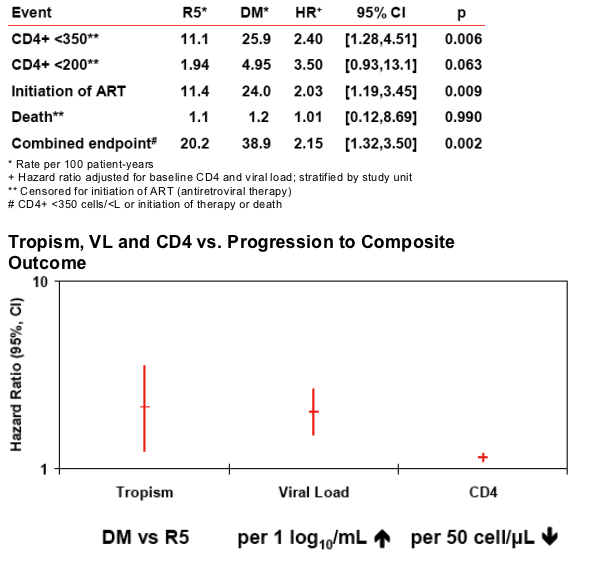 |
 |
 |
| |
Prediction of disease progression by HIV co-receptor tropism (CRT) in persons (P) with untreated chronic HIV infection
|
| |
| |
Reported by Jules Levin
ICAAC Sept 17-20, 2007, Chicago
Matthew B. Goetz1 , Robert Leduc2, Jay R. Kostman3, Ann Labriola4, Yolanda Lie5, Jodi Weidler5, Eoin Coakley5, Roberta Luskin-Hawk6, for the Long Term Monitoring (LTM) Study, Terry Beirn Community Programs for Clinical Research on AIDS (CPCRA 060)
1VA Greater Los Angeles Healthcare System, 2University of Minnesota, Minneapolis, MN, USA, 3UPHS/Presbyterian Medical Center, Philadelphia, PA, USA, 4 VA Medical Center, Washington, DC, USA, 5Monogram Biosciences, South San Francisco, CA, USA, 6Saint Joseph Hospital, Chicago, IL, USA
Acknowledgements: Support was provided by NIAID grants U01 AI042170, U01 AI046362 and U01 AI068641 (CPCRA & INSIGHT) and R44AI050321 (NIAID SBIR grant to Monogram Biosciences).
AUTHOR SUMMARY
In this population of treatment naive patients with early stage HIV infection:
Patients with detectable X4 virus had evidence of more rapid of HIV disease
progression than did persons with pure R5 virus
The impact of Dual/Mixed tropic virus was:
-- similar to that of a one log/mL increase in plasma HIV RNA
-- greater than that of a 50 cell/_L decrease in the CD4+ cell count
These effects was observed in analyses that controlled for the baseline
CD4+ count, viral load, HIV risk factors, demographic factors and other
laboratory variables.
BACKGROUND
The relative ease of new methods for assaying HIV-1 co-receptor tropism coupled with the development of specific inhibitors of HIV-1 utilization of the CCR5 co-receptor, has led to increased interest in assessing the relationship between HIV-1 co-receptor utilization and the rate of HIV disease progression. However, few studies have assessed the prognostic significance of infection by CCR5 or CXCR4 tropic HIV-1 isolates in a diverse population of chronically infected, treatment naive patients with relatively preserved CD4+ cells counts. Herein we describe the relationship between viral tropism and HIV disease progression in such a cohort, namely the treatment-naive participants who have been enrolled in the Long-Term Monitoring Protocol (LTM) sponsored by the Terry Beirn Community Programs for Clinical Research on AIDS (CPCRA).
AUTHOR DISCUSSION
In this prospectively studied cohort of 314 patients with chronic untreated HIV-1 infection, individuals with Dual/Mixed tropic virus had a faster rate of HIV disease progression whether assessed by a composite outcome of CD4+ count
<350 cells/_L, treatment initiation or death, or by separate analyses of time to
CD4+ count <350 cells/_L or treatment initiation.
These data confirm and extend earlier reports regarding X4 tropism and
disease progression to truly treatment naive adults with relatively early stage
HIV-1 infection (median of 630 CD4+ cells/_L at baseline). Previous studies
have shown a similar relationship between tropism and:
-- CD4+ decline in patients with approximately 300 cells/_L CD4+ cells (3)
--Progression to AIDS in patients from the Multicenter AIDS Cohort Study (2)
-- Viral load increases during the first year after HIV seroconversion (4)
Strengths of this study include the demographic diversity, prospective data collection and long follow-up. A potential weakness is that persons categorized as having R5 virus may harbor subpopulations of X4 virus below the limits of detection of the Trofile assay (1). Thus individuals categorized as having only R5 tropic virus may have had small subpopulations of Dual/Mixed tropic virus. However, such misallocations would tend to weaken rather than strengthen the association between baseline dual/mixed tropic virus with more rapid disease progression. In other studies of this cohort, we have found that baseline Dual/Mixed tropic and viral replicative capacity independently predict the rate of HIV disease progression (5).
OBJECTIVES & METHODS
To determine the distribution of co-receptor tropism at study entry
To determine the relationship of baseline co-receptor tropism with
-- Baseline viral load and CD4+ count
-- The time to < 350 CD4+ cells/< L, initiation of therapy or death (first event), i.e., the primary endpoint
Study Population
Inclusion criteria for enrollment in the master CPCRA LTM treatment naive cohort required that patients be HIV infected, be greater than 12 years old, be anti-retroviral naive, and provide written informed consent. There were no exclusion criteria. The association between baseline viral tropism and HIV disease progression was determined in the subset of LTM treatment naive patients who met the following additional eligibility criteria: a minimum of 4 months of follow-up during which antiretroviral therapy was not initiated, a
baseline viral load >1,000 HIV RNA copies/mL and CD4 count >450 cells/< L, and the availability of sufficient plasma for laboratory analyses.. Co-receptor tropism assays were done using the Trofile Assay (Monogram Biosciences, South San Francisco, CA).
RESULTS
Of the 1050 treatment naive patients enrolled in LTM, 359 met the entry criteria for analysis of viral tropism. Viral tropism assays were available for 313 patients; 18 participants did not have available baseline plasma specimens and viral tropism assays were unsuccessful in 27 other persons due to low viral loads and plasma volume.
Dual/mixed R5/X4-tropic virus (DM) was detected in 32 samples (10%) and R5-tropic virus was detected in 282 (90%) samples; no sample had pure X4-tropic virus. 185 patients reached the primary endpoint. The distribution of first events was as follows: reaching a CD4+ count < 350 cells/_L (n=112); initiation of antiretroviral therapy (n=65); and death (n=8).
Patient Characteristics vs Tropism Status
Latinos had more dual/mixed compared to R5 (25% vs 8%, p<0.01). Although not statistically significant, among whites 44% had R5 and 28% X4. Median CD4 was 635 among R5 and 571 in X4, but not a significant difference. Median viral load was 4.4 log among dual/mixed and 4.1 log in R5, but not a significant difference.


+ Hazard ratio adjusted for baseline CD4 and viral load, gender, race, same sex exposure, HCV status; stratified by study unit.
Similar results were observed if patients who began therapy within 8 or 12
months of study entry were excluded from analysis
Time to Component Outcomes
Hazard ratio to reaching CD4 of less than 350 is 2.40 if DM vs R5 (p=0.006). The rate per 100 patient years is 11.1 for R5 and 25.9 for DM (p=0.006). For time to reaching CD4 <200 the rate per 100 patuent years is 1.94 for R5 vs 4.95 for X4 (HR 3.50, p=0.063). For reaching death there was no difference whether patient was X4 or R5. For time to initiation of therapy, rate per 100 patient years was 11.4 for R5 and 24.0 for X4 (HR 2.03, p=0.009). For the combined endpoint of CD4 <350 or inititiation of therapy: rate per 100 patient years was 20.2 for R5 and 38.9 for DM (HR 2.15, p=0.002).

References
1. Whitcomb JM, et al. Antimicrob Ag Chemother. 200; 51:566.
2. Shephard J et al. XVI IAC. Abstract TUPE0001; 2006.
3. Waters LJ, et al. 46th ICAAC. Abstract H-1667; 2006.
4. De Mendoza C, et al.. 14th CROI. Abstract 383; 2006.
5. Goetz MB et al. 4th IAS Conference on HIV Pathogenesis, Treatment and Prevention. WEPDB07. 2007.
|
| |
|
 |
 |
|
|